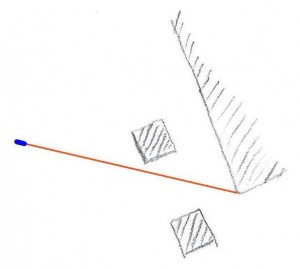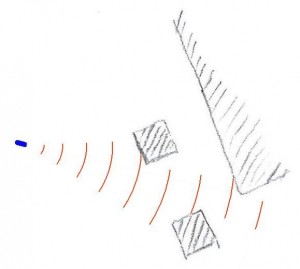Ultrasonic or laser rangefinder?
If you intend to buy a rangefinder, there is the dilemma of financial engineering. Do you purchase a more expensive laser rangefinder, or take possession of a low-cost model that works on ultrasound. Some theoretical background and practical information are essential and help you to make the right choice.
High accuracy and precision of measurement – rangefinder can measure distances even with millimeter precision and achieve this result with very high repeatability. Millimeter of error is very difficult to measure using traditional tape or other gauges, especially when measuring longer distances.
A tachymeter – rangefinder measures the distance without the need for special mirrors or reflective material. The electromagnetic wave emitted by the instrument is reflected from the object which is in the focus back to the instrument. The distance is determined by the analysis of the returning wave.
Long range – there are manual rangefinders on the market, which measure kilometer distance, but with low accuracy. Most instruments allow construction class set length 250 -meter sections.
Calculations on the screen – some rangefinders can calculate various values based on the measured length. Simple instruments calculate surface and volume, more advanced rangefinders can determine inaccessible segment lengths using the Pythagorean theorem, and the top-shelf tools show even the inclination of objects.
Miniature size – manual rangefinders are small, lightweight, resistant to adverse weather conditions, and run on 2-3 batteries, which allow several thousand measurements.
Manual rangefinders that can be found on the market are divided into two basic groups:
- electromagnetic rangefinders (special case of a laser distance meters)
- ultrasonic rangefinders
The first group may be due to the technique of determining the distance be divided
- pulse based rangefinders
- phase based rangefinders
Ultrasonic or laser?
To answer the title question a few words of useful theory. At the heart of each laser rangefinder is the opto- electronic system. This is responsible for sending an electromagnetic pulse (laser) and the reception of the reflected signal and its analysis. The pulse sent by the transmitter reaches the measured object, is reflected from its surface and returns to the rangefinder, where the electronic system determines the distance:
- calculating the time by measuring the phase shift of waves sent and returning – in rangefinders phase,
- based on direct measurement of the time it takes the impulse to travel a double line between rangefinder and an object – in rangefinder’s pulse.
Ultrasonic rangefinders operate on a similar principle as laser rangefinders. Here, however, the transmitting unit consists of a speaker and a microphone. The speaker does not emit electromagnetic waves, but a sound wave. The electronic module measures the time that elapses from the sending of the ultrasonic signal to receive the returning echoes through the receiver.
Which is better?
Advantages and disadvantages of laser rangefinders and ultrasonic rangefinders result directly of the type of waves they use to measure distances. Even if the rate determining distance is closely dependent on the propagation speed of the waves – electromagnetic speed of about 300 000 km/s (speed of light) and ultrasound at about 343 m/s (speed of sound in air). Both types of waves bring with them basic physical phenomena – reflection, refraction and absorption. The different behavior of the electromagnetic wave and ultrasonic rangefinders both types have their advantages and disadvantages.
What are the advantages of laser rangefinders?
- very high accuracy (eg, 1 mm, phase range finders)

Measuring with a laser beam
- high reliability of the measurements in difficult terrain and obstacles
- a very large range coming up to over 1,000 m (pulse rangefinders)
- high efficiency measurement for objects reflecting the signal at a high angle
- visible laser spot, which serves as an indicator and facilitates targeting
- speed of operation – laser rangefinder measure several meters distance in about 1 second
- integration with measurement and calculation and the usability of the designated length to calculate other geometric values (e.g., surface area )
- Low energy consumption – taking even a few thousand measurements with 2 to 4 batteries
What are the disadvantages of laser rangefinders?
- relatively low accuracy of pulse rangefinders
- lack of measurement of transparent objects
- considerable sensitivity to work in direct sunlight indoors and outdoors in full sun – often reflected signal is dispersed and its power after returning to the receiving system is not sufficient to determine the distance
What are the advantages of ultrasonic rangefinders?
- the ability to measure transparent objects , including the surface of water

Measuring with ultrasound
- low purchase price
What are the disadvantages of ultrasonic rangefinders?
- very small measuring range (up to several meters )
- requires the user to very closely control the measurements due to the risk of errors resulting from reflections from random items / objects – ultrasonic rangefinders work best in empty rooms or the open air
- very low accuracy
- limited use in engineering applications
- low efficiency measurement for objects reflecting the signal at a high angle
Everything we have to know
Looking at the above points, go ahead, it is clear that the ultrasonic rangefinders lose virtually every aspect of the competition with laser rangefinders.
Finally, an important note – some ultrasonic rangefinders on the market are equipped with a laser spot that acts as an indicator. Please be careful, because an ultrasonic rangefinder still measures based on ultrasound. In such models the laser is just for aiming the target.